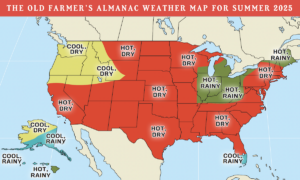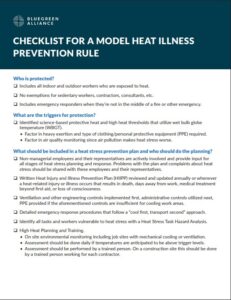
Preventing Heat-Related Illnesses

Credit: The 2025 Old Farmer’s Almanac
There is no question that the United States, like the rest of the world, is getting hotter. NASA reports that 18 of the 19 warmest years on record have occurred since 2000. Forecasters, including the Old Farmer’s Almanac, are predicting that summer 2025 in the United States will be another “scorcher.”
As summers get hotter and longer, more workers are dying from heat. The Bureau of Labor Statistics (BLS) data shows that worker heat deaths have doubled since the early 1990s. As heat-related deaths increase, much more needs to be done to protect workers from heat-related injuries and illnesses.
The BlueGreen Alliance—along with the United Auto Workers (UAW), United Steelworkers (USW), International Union of Painters and Allied Trades (IUPAT), Service Employees International Union (SEIU), National Wildlife Federation (NWF), Natural Resources Defense Council (NRDC), Ceres, the Union of Concerned Scientists, and National Employment Law Project (NELP)—have developed a checklist that companies, universities, cities, counties, and states can use to protect workers from heat.
Heat protections aren’t just the right thing to do; they’re the financially smart thing to do. Establishing heat safe workplaces and practices can improve employee productivity and morale and reduce preventable costs to employers. Ultimately, the benefits of workplace heat protection outweigh the costs of implementation. NRDC and BGA provide talking points on the economic benefits of workplace heat safeguards in this factsheet.
Further, new rules will need to address the disproportionate impact of heat stress on workers of color, specifically Latines. Since 2010, Latines have comprised one-third of all worker heat fatalities despite making up just 17% of the U.S workforce. Experts attribute that figure to overrepresentation in industries that have a higher risk of extreme heat exposure, such as agriculture and construction.


